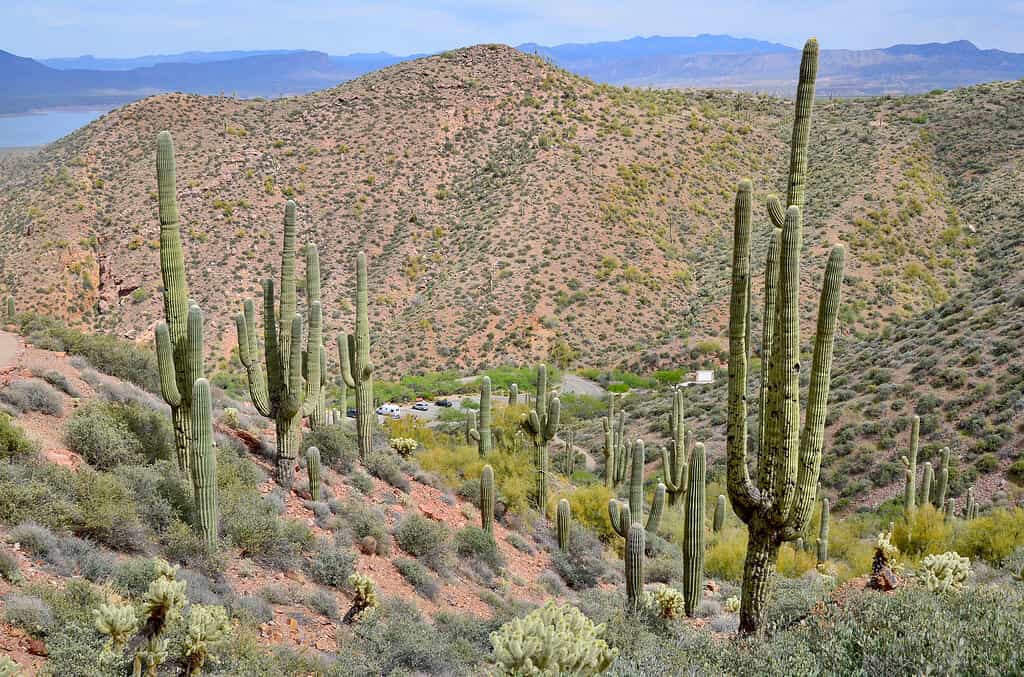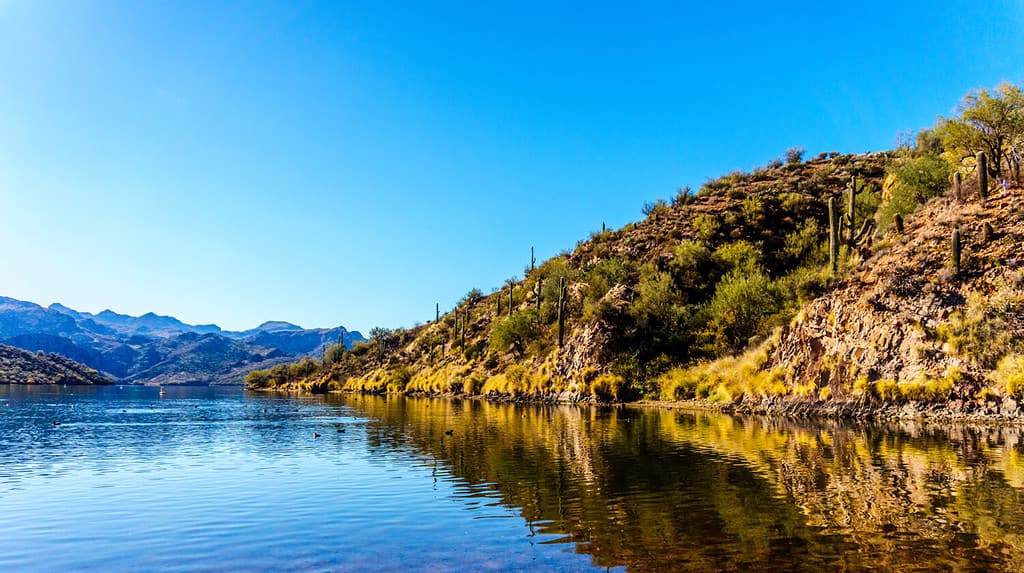Saguaro Lake is a mesmerizing reservoir nestled amidst the captivating beauty of the Sonoran Desert in Arizona. Adventurers, nature enthusiasts, boaters, and anglers all flock to the area. It sits within an easy drive of the largest city in Arizona. So visitors from out of state have easy access to this stunning desert getaway. But what is so special about Saguaro Lake, and why should you visit it? Below, we’ll explore important details about this beautiful lake, including things to do while you are there.
Location
Saguaro Lake sits within the expansive Tonto National Forest. Positioned less than 30 miles from Mesa, AZ, this stunning lake showcases the beauty of the Sonoran Desert. Rugged desert cliffs dotted with magnificent saguaro cacti offer visitors incredible vistas. The lake is also reasonably close to Phoenix, which makes it one of the more popular regional getaways.

The expansive Saguaro Lake is perfect for fishing and often rewards anglers with large catches.
©iStock.com/Monica Lara
History
The lake developed following the construction of Stewart Mountain Dam in 1930. The dam plays a vital role in water storage for the Phoenix metropolitan area and facilitates irrigation and power generation for the region.
Size
The expansive reservoir boasts an impressive surface area of approximately 1,264 acres and sits just over 1,500 feet above sea level. Its significant surface area and 22 miles of shoreline mean there is ample space for outdoor activities. The lake is approximately 10 miles long and has countless fingers jutting off into inlets and coves. These features offer ample natural seclusion. So visitors can easily find a quiet spot to enjoy the desert surroundings or catch their favorite fish.
Depth
Saguaro Lake is a popular destination for Arizona boaters and anglers. And for good reason. The deepest reaches of the lake exceed a stunning 110 feet. However, the average depth is around 90 feet, which is still impressive. The depth of Saguaro Lake ensures boats have no trouble moving around the large body of water.
Additionally, the deep lake ensures its fish population remains diverse. Largemouth bass, smallmouth bass, crappie, catfish, and sunfish are just a few game fish living there.
Water Level
It is slightly difficult to pinpoint the water level of saguaro lake. After all, it is subject to fluctuations due to rainfall, snowmelt, and dam releases. Water levels are the highest in the spring, following the winter rains and snowmelt. As the summer progresses, water levels may gradually recede due to reduced rainfall and increased demand for water supply.
Since Saguaro Lake is a meticulously managed reservoir, most years, there are no major fluctuations. But visitors need to stay informed about the current water levels. Current water levels will directly impact boating access, fishing conditions, and the overall experience of exploring this captivating reservoir. If you wish to visit the lake, you can find current watershed levels here or speak with the Forest Service rangers.
Geology
The geology surrounding Saguaro Lake showcases the magnificent forces that have shaped the land over millions of years. There are breathtaking rugged cliffs and canyons around the lake. A combination of ancient volcanic rocks, rugged metamorphic formations, and layers of sedimentary deposits forms them.
You may find volcanic rocks in the area. These rocks, composed of lava flows and pyroclastic deposits, formed after volcanic activity millions of years ago.
Saguaro Lake also highlights layers of sedimentary deposits composed of sandstone, shale, and limestone. These layers contain fossilized remains of plants and animals. Prehistoric life once thrived in this region.
Saguaros
Anyone who has seen photos of the desert southwest is likely familiar with towering saguaro cacti (Carnegiea gigantea). They are the largest cacti in the U.S. and can reach up to 60 feet high at maturity. Saguaros are native to the Sonoran Desert and are abundant throughout Arizona and Sonora, Mexico.
Saguaros are notable for the “arms” that they form as they grow. These arms reach up and out toward the sky. They sometimes form intricate, striking patterns. Most often, they only develop a few arms. But some don’t form arms at all, and others may grow up to 25!
One of the most fascinating facts about saguaros is how useful they are. Once these cacti die, their strong ribs prove quite valuable. You can use them to create water containers, fences, furniture, and even roofing material.

Saguaros are the largest cacti in the U.S. and can reach up to 60 feet high at maturity!
©meunierd/Shutterstock.com
Fishing
Saguaro Lake has rightfully earned its reputation as a paradise for fishing enthusiasts. The lake’s rich ecosystem supports many fish species. These include crappie, rainbow trout, sunfish, largemouth, smallmouth and yellow bass, walleye, channel catfish, carp, yellow perch, and tilapia. Such a diverse offering means anglers can fish from boats, on shore, or take a fishing charter into deeper waters.
Saguaro Lake’s fishing season runs throughout the year. But the activity of each species will vary by season. So, always check to make sure your preferred fish is biting before making the trek.
All visitors must purchase a pass to get to the lake. Daily passes and annual passes are available. And anyone wishing to fish from a boat must buy an additional sticker for their watercraft.
Boating and Other Activities
The spectacular Saguaro Lake also offers plenty of other activities beyond finishing. An array of boating choices allows every visitor to enjoy the pristine, calming waters. Consider embarking on kayaking adventures, navigating the lake on jet skis, exploring tranquil coves on paddleboards, or hoisting sails for a relaxing sailing experience.
Saguaro Lake amenities include two paved boat ramps that work for motorized and non-motorized crafts. There is a small fee for every vessel hitting the water. Visitors can take care of that upon their arrival at the lake. Rangers closely monitor the number of boats on the lake at any given time. Arriving earlier in the day may give you a better shot at making it to the water instead of getting turned away.
The lake’s calm waters are also ideal for water skiing and wakeboarding. Any craft towing those on waterskis and wakeboards must pay the same vessel fee as any other boat.
At more sheltered coves and along the shoreline, kayakers and paddleboarders will find a serene and beautiful experience.
In addition to water sports, Saguaro Lake provides ample opportunities for picnicking and wildlife watching. Many visitors anchor their boats in secluded areas and enjoy the quiet views.
Wildlife enthusiasts will delight in the diverse array of bird species that call Saguaro Lake their home. Ospreys, bald eagles, herons, and various migratory birds can be spotted soaring above the lake’s surface or perched on the branches of nearby trees, adding a touch of natural beauty to the boating experience.
Staying at Saguaro Lake
Camping
There is a small, 10-spot campground that is boat access only just down the river from the lake. Spots fill up quickly, but Tonto National Forest has plenty of other nearby campgrounds.
A few of the area campgrounds let visitors truly immerse themselves in the Sonoran Desert beauty. Coon Bluff Recreation Area and Canyon Lake Campground are situated within an easy drive of the lake. If those spots fill up, consider pitching a tent or parking an RV at a campground a little further away. Lost Dutchman State Park has gorgeous and relaxing camping options. And Buckhorn Family Campground is just down the road.
Lodging
Not everyone is a fan of camping, though. Thankfully, Saguaro Lake Guest Ranch has cabins available to rent. You can stay there, dine, and take advantage of area activities. All within the comfort of modern conveniences.

Saguaro Lake and the surrounding mountains with its cacti under clear blues skies in the Arizona Desert.
©Harry Beugelink/Shutterstock.com
The photo featured at the top of this post is © Harry Beugelink/Shutterstock.com
Thank you for reading! Have some feedback for us? Contact the AZ Animals editorial team.







